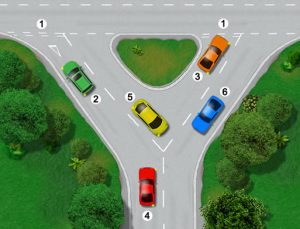As with T junctions and Y junctions and their corresponding letters, D junctions get their name due to looking like the letter D. D junctions aren’t widely used and it’s quite possible you’ll not have seen one due to being used in specific locations such as Maidstone, Kent.

They are effectively a T junction that divides, or splits at the end, though the minimal road markings can cause confusion to road users who are not familiar with them.
If you do have D junctions in your area, it’s likely that the examiner will use them as part of your driving test routes. Though the D junction resembles the Y junction, they should be used differently. This tutorial will explain how to correctly use D junctions.
- Take note of the double junction lines and give way road markings. On roads that are not well maintained, junction lines may be faded. There may or may not be give way road markings (the painted triangle) and give way signs.
- For merging onto the primary road, use the left fork for turning left
- For merging onto the primary road, use the right fork for turning right.
- When turning right out of the D junction, give way to any vehicles that may have entered the junction from the left and that will cross your path (5).
- When turning right from the primary road and entering the D junction, give way to any vehicles crossing your path from the left (6).
Practice the Junctions
You may find that the local area is combined with other types of junctions and road markings may be faded due to poor maintenance. If you are learning to drive, use an experienced local driving instructor to take you through the various junctions within the area and practice them.
TUTORIALS AND GUIDES RELATED TO JUNCTIONS
- Junctions
- Y junctions
- Types of junctions
- Turning left at a junction
- Turning right at a junction
- Box junction
- Staggered junction
- Junction lines
- Junction signs
- Emerging from a junction
- Creep and peep
